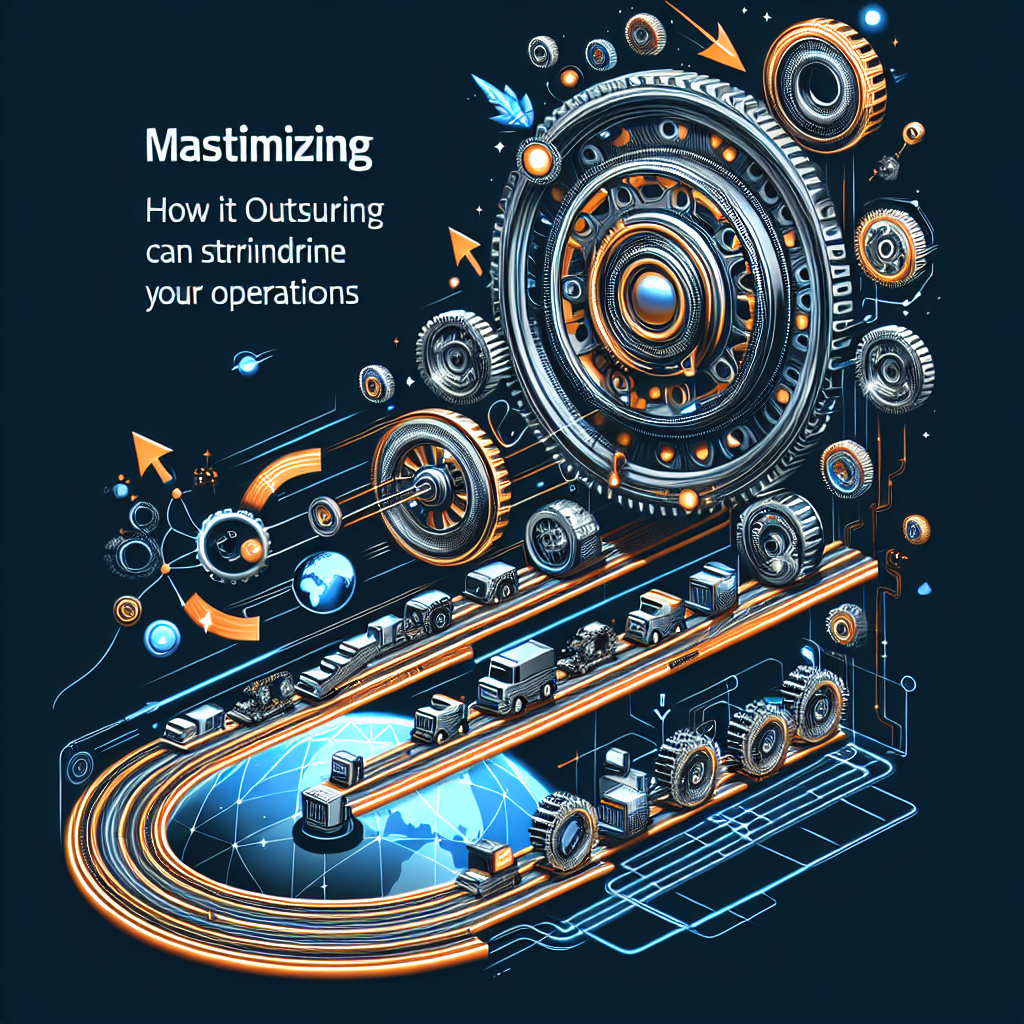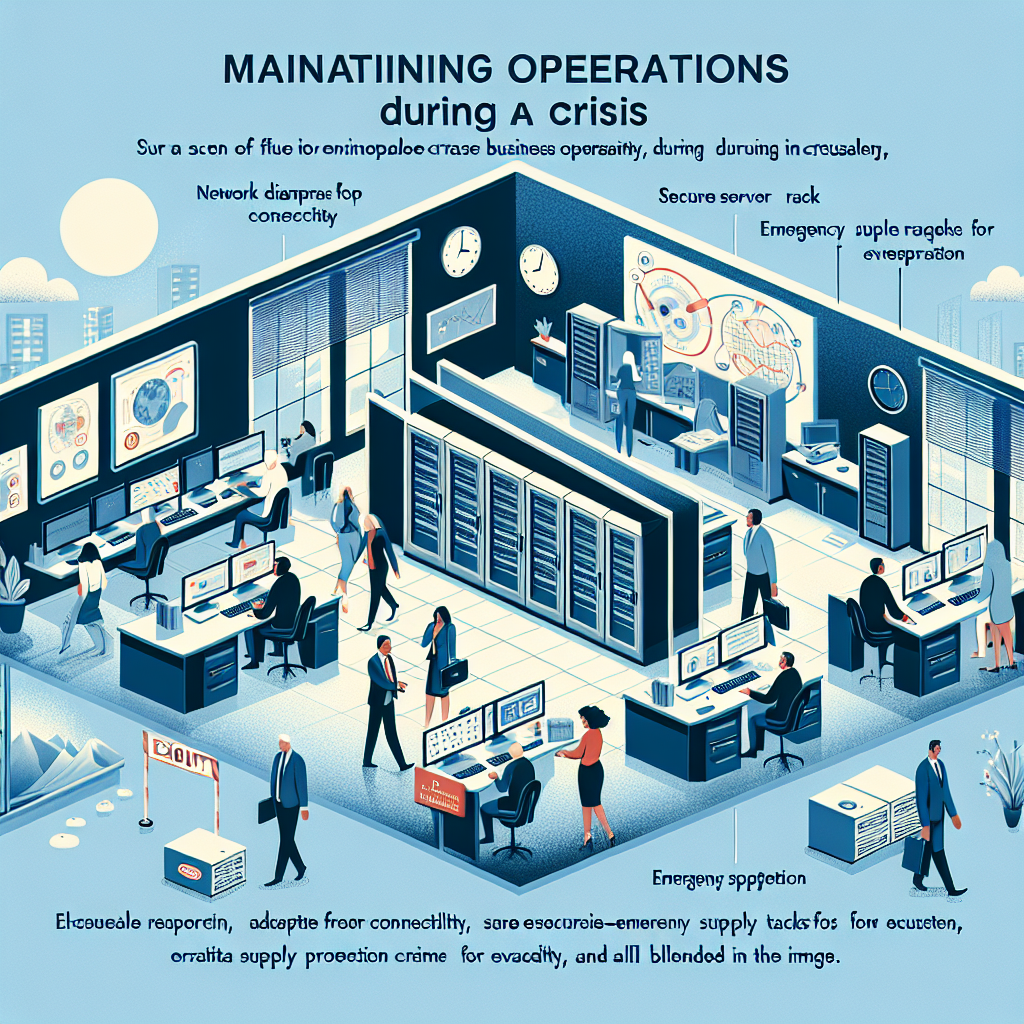Your cart is currently empty!
Tag: Operations

The Top IT Solutions to Streamline Your Business Operations
In today’s fast-paced business environment, technology plays a crucial role in streamlining operations and increasing efficiency. With the right IT solutions, businesses can automate processes, improve communication, and enhance productivity. Here are some top IT solutions that can help streamline your business operations:1. Cloud Computing: Cloud computing allows businesses to store and access data and applications over the internet, rather than on local servers. This solution offers scalability, flexibility, and cost-effectiveness, making it easier for businesses to access resources and collaborate with team members from anywhere in the world.
2. Enterprise Resource Planning (ERP) Systems: ERP systems integrate various business functions, such as finance, human resources, and supply chain management, into a single platform. This solution helps businesses streamline processes, improve decision-making, and enhance collaboration across departments.
3. Customer Relationship Management (CRM) Software: CRM software helps businesses manage customer relationships and interactions, track sales leads, and improve customer service. This solution enables businesses to centralize customer data, automate marketing campaigns, and analyze customer behavior to drive sales and improve customer satisfaction.
4. Business Intelligence (BI) Tools: BI tools enable businesses to analyze and visualize data to make informed decisions and optimize performance. These tools can help businesses identify trends, forecast sales, and monitor key performance indicators to improve operations and drive growth.
5. Collaboration Tools: Collaboration tools, such as project management software and communication platforms, help teams work together more effectively and efficiently. These tools enable teams to share files, communicate in real-time, and track progress on projects, leading to improved collaboration and productivity.
6. Security Solutions: With the increasing risk of cyber attacks and data breaches, businesses need to invest in security solutions to protect their sensitive information. Security solutions, such as firewalls, antivirus software, and encryption tools, help businesses safeguard their data and prevent unauthorized access.
7. Mobile Applications: Mobile applications enable businesses to access information and communicate with customers and employees on the go. These applications can streamline processes, improve customer engagement, and increase productivity by providing access to key data and tools anytime, anywhere.
By implementing these top IT solutions, businesses can streamline their operations, improve efficiency, and stay competitive in today’s digital landscape. Investing in the right technology can help businesses drive growth, reduce costs, and enhance customer satisfaction, ultimately leading to long-term success.

Top Network Management Tools for Streamlined Operations
In today’s fast-paced business environment, it is crucial for organizations to have efficient network management tools in place to ensure smooth operations and optimal performance. With the increasing complexity of networks and the growing number of devices connected to them, having the right tools can make all the difference in streamlining operations and maximizing productivity.Here are some of the top network management tools that can help organizations achieve streamlined operations:
1. SolarWinds Network Performance Monitor (NPM): SolarWinds NPM is a comprehensive network monitoring tool that provides real-time visibility into network performance and helps identify and resolve issues before they impact operations. It offers advanced features such as customizable dashboards, automated network discovery, and intelligent alerting to help IT teams stay on top of network performance.
2. PRTG Network Monitor: PRTG Network Monitor is another popular network management tool that offers comprehensive monitoring capabilities for networks of all sizes. It provides in-depth insights into network performance, bandwidth usage, and device health, making it easier for IT teams to proactively manage their networks and prevent issues from occurring.
3. ManageEngine OpManager: ManageEngine OpManager is a robust network management tool that offers a wide range of features, including network monitoring, performance analysis, and fault management. It provides a centralized dashboard for monitoring network devices, servers, and applications, making it easier for IT teams to identify and resolve issues quickly.
4. Cisco Prime Infrastructure: Cisco Prime Infrastructure is a network management tool specifically designed for Cisco networks. It offers a comprehensive suite of features, including network monitoring, configuration management, and performance optimization. With Cisco Prime Infrastructure, organizations can effectively manage their Cisco networks and ensure optimal performance.
5. Nagios XI: Nagios XI is a powerful network monitoring tool that offers a wide range of features for monitoring network performance, availability, and security. It provides customizable dashboards, advanced alerting, and reporting capabilities to help IT teams effectively manage their networks and ensure smooth operations.
6. Zabbix: Zabbix is an open-source network monitoring tool that offers a flexible and scalable solution for monitoring network performance and availability. It provides real-time monitoring, alerting, and reporting capabilities to help IT teams proactively manage their networks and address issues quickly.
In conclusion, having the right network management tools in place is essential for organizations looking to streamline operations and maximize productivity. By leveraging the advanced features and capabilities of these top network management tools, IT teams can effectively monitor network performance, identify and resolve issues quickly, and ensure the smooth operation of their networks.

Proactive Maintenance: A Key Component of Efficient Operations
Proactive maintenance is a crucial aspect of ensuring that operations run smoothly and efficiently in any organization. By taking a proactive approach to maintenance, businesses can prevent costly breakdowns, reduce downtime, and extend the lifespan of their equipment and machinery. This ultimately leads to increased productivity, lower maintenance costs, and improved overall performance.One of the key benefits of proactive maintenance is that it allows businesses to identify and address potential issues before they escalate into major problems. By regularly inspecting and maintaining equipment, businesses can catch small issues early on and make the necessary repairs or replacements before they cause a breakdown. This not only saves time and money, but also prevents disruptions to production schedules and ensures that operations can continue running smoothly.
Proactive maintenance also helps businesses to extend the lifespan of their equipment. By keeping machinery well-maintained and operating at peak performance, businesses can avoid premature wear and tear that can lead to costly replacements. Regular maintenance can help to improve the efficiency of equipment, reduce energy consumption, and prolong its useful life, ultimately saving money in the long run.
Furthermore, proactive maintenance can help businesses to plan and budget for maintenance activities more effectively. By scheduling regular maintenance tasks in advance, businesses can avoid unexpected costs and downtime associated with emergency repairs. This allows businesses to better allocate resources, plan for maintenance expenses, and optimize their maintenance schedules to minimize disruptions to operations.
In order to implement an effective proactive maintenance program, businesses should establish a comprehensive maintenance plan that outlines the tasks, schedules, and procedures for maintaining equipment. This may include regular inspections, lubrication, cleaning, calibration, and testing of equipment to ensure that it is operating properly. Businesses should also invest in training for maintenance staff to ensure that they have the skills and knowledge to carry out maintenance tasks effectively.
In conclusion, proactive maintenance is a key component of efficient operations in any organization. By taking a proactive approach to maintenance, businesses can prevent costly breakdowns, extend the lifespan of their equipment, and improve overall performance. By implementing a comprehensive maintenance plan and investing in training for maintenance staff, businesses can ensure that their operations run smoothly and efficiently, ultimately leading to increased productivity and reduced maintenance costs.

The Role of Technical Support in Ensuring Smooth Operations for Businesses
Technical support plays a crucial role in ensuring smooth operations for businesses in today’s technology-driven world. From troubleshooting IT issues to providing guidance on software and hardware upgrades, technical support teams are essential for maintaining the efficiency and effectiveness of a company’s operations.One of the key responsibilities of technical support is to address and resolve any technical issues that may arise within the organization. This includes troubleshooting software and hardware problems, network connectivity issues, and any other technical challenges that may impact the day-to-day operations of the business. By quickly identifying and resolving these issues, technical support helps minimize downtime and ensures that employees can continue to work productively.
In addition to addressing immediate technical issues, technical support also plays a proactive role in preventing future problems. This includes conducting regular maintenance and updates to ensure that systems are running smoothly and securely. By staying ahead of potential issues, technical support helps prevent costly downtime and disruptions to the business.
Technical support also plays a critical role in helping businesses adapt to new technologies and stay competitive in their industry. Whether it’s implementing new software systems, upgrading hardware, or integrating new technologies into existing systems, technical support teams provide the expertise and guidance needed to ensure a smooth transition. By staying up-to-date on the latest technological advancements, technical support helps businesses leverage new opportunities and stay ahead of the competition.
Furthermore, technical support teams play a vital role in training and supporting employees on how to effectively use technology within the organization. This includes providing guidance on best practices, troubleshooting common issues, and offering ongoing support to ensure that employees can maximize the use of technology in their day-to-day tasks. By empowering employees with the knowledge and skills they need to leverage technology effectively, technical support helps drive efficiency and productivity within the organization.
Overall, technical support is a critical function within any business, playing a key role in ensuring smooth operations, preventing technical issues, and supporting employees in leveraging technology effectively. By providing timely and effective support, technical support teams help businesses maintain their competitive edge and drive success in today’s fast-paced, technology-driven world.

Top 10 IT Solutions for Streamlining Your Business Operations
In today’s fast-paced business world, it’s essential for companies to stay ahead of the curve when it comes to technology. With the right IT solutions in place, businesses can streamline their operations, increase productivity, and ultimately drive growth. Here are the top 10 IT solutions that can help streamline your business operations:1. Cloud Computing: Cloud computing allows businesses to store and access their data and applications over the internet, eliminating the need for physical servers and hardware. This can greatly reduce costs and improve flexibility and scalability.
2. Business Process Automation: Using software to automate repetitive tasks and workflows can save time and improve efficiency. From email marketing to customer service, there are numerous tools available to streamline business processes.
3. Customer Relationship Management (CRM) Software: CRM software helps businesses manage relationships with customers and track sales and marketing activities. By centralizing customer data, businesses can improve customer service and increase sales.
4. Enterprise Resource Planning (ERP) Systems: ERP systems integrate various business functions, such as finance, inventory, and human resources, into one centralized platform. This can streamline operations and improve communication between departments.
5. Project Management Tools: Project management tools help businesses plan, organize, and track projects and tasks. This can improve collaboration among team members and ensure projects are completed on time and within budget.
6. Cybersecurity Solutions: With the increasing threat of cyber attacks, it’s essential for businesses to invest in cybersecurity solutions to protect their data and systems. This can include firewalls, encryption, and security monitoring tools.
7. Mobile Apps: Mobile apps can help businesses connect with customers and employees on the go. From mobile payment options to employee scheduling tools, there are numerous ways mobile apps can streamline business operations.
8. Data Analytics Tools: Data analytics tools help businesses analyze their data to make informed decisions and identify trends and patterns. This can improve business performance and drive growth.
9. Communication and Collaboration Tools: Communication and collaboration tools, such as video conferencing and instant messaging platforms, help businesses connect with employees and clients regardless of location. This can improve communication and productivity.
10. Internet of Things (IoT) Devices: IoT devices, such as smart sensors and connected devices, can collect and exchange data to improve business operations. From inventory management to predictive maintenance, IoT devices can streamline various aspects of a business.
In conclusion, investing in the right IT solutions can help businesses streamline their operations, improve efficiency, and ultimately drive growth. By staying up to date with the latest technology trends and implementing the right tools, businesses can stay ahead of the competition and achieve success in today’s digital age.

Maximizing Efficiency: How IT Outsourcing Can Streamline Your Operations
In today’s fast-paced business environment, maximizing efficiency is crucial for staying competitive and meeting customer demands. One way to achieve this is through IT outsourcing, which can streamline your operations and improve overall productivity.IT outsourcing involves hiring external IT service providers to handle certain aspects of your business’s technology needs. This can include managing software development, network maintenance, cybersecurity, and more. By outsourcing these tasks, you can free up internal resources and focus on core business activities.
One of the key benefits of IT outsourcing is the ability to access specialized expertise. IT service providers often have a team of skilled professionals with years of experience in various technologies and industries. This means they can quickly and efficiently address any IT issues that arise, minimizing downtime and ensuring smooth operations.
Outsourcing IT services also allows your business to stay up-to-date with the latest technology trends. IT service providers are constantly monitoring the market for new developments and innovations, and can help you implement cutting-edge solutions that improve efficiency and drive growth.
Additionally, outsourcing IT services can help reduce costs. By hiring external providers, you can avoid the expenses associated with hiring and training internal IT staff, as well as investing in expensive hardware and software. This can result in significant cost savings for your business.
Furthermore, outsourcing IT services can improve scalability and flexibility. As your business grows, you can easily scale up or down your IT services to meet changing demands. This flexibility allows you to adapt quickly to market changes and stay ahead of the competition.
Overall, IT outsourcing can streamline your operations and maximize efficiency in several ways. By leveraging specialized expertise, staying current with technology trends, reducing costs, and improving scalability, outsourcing IT services can help your business achieve its goals and drive success in today’s competitive marketplace.

Streamlining Operations with Integrated IT Solutions
In today’s fast-paced business environment, efficiency is key to staying competitive. Streamlining operations is essential for maximizing productivity and profitability. One way to achieve this is by implementing integrated IT solutions that bring together various systems and processes into a cohesive and seamless workflow.Integrated IT solutions combine different technologies and tools to create a centralized platform that connects various departments and functions within an organization. This allows for real-time data sharing, automated processes, and improved communication among team members. By streamlining operations through integrated IT solutions, businesses can eliminate manual tasks, reduce errors, and increase operational efficiency.
One of the key benefits of integrated IT solutions is improved collaboration among employees. With a centralized platform, team members can easily access and share information, collaborate on projects, and communicate in real-time. This streamlines communication and decision-making processes, leading to faster project completion and more efficient workflows.
Another advantage of integrated IT solutions is the ability to automate repetitive tasks. By integrating different systems and processes, businesses can automate routine tasks such as data entry, invoicing, and reporting. This not only saves time and reduces errors but also allows employees to focus on more strategic tasks that add value to the business.
Additionally, integrated IT solutions provide better visibility into business operations. By consolidating data from various systems and sources, businesses can gain a comprehensive view of their operations and performance. This allows for better decision-making, improved forecasting, and more informed strategic planning.
Overall, streamlining operations with integrated IT solutions can help businesses achieve greater efficiency, productivity, and profitability. By connecting various systems and processes into a centralized platform, businesses can improve collaboration, automate tasks, and gain better visibility into their operations. As technology continues to evolve, integrated IT solutions will play an increasingly important role in helping businesses stay competitive and adapt to the changing business landscape.

Maximizing Efficiency: How IT Consulting Can Improve Your Business Operations
In today’s fast-paced business world, maximizing efficiency is key to staying ahead of the competition. One way to achieve this goal is through IT consulting services. By partnering with a team of experts in information technology, businesses can streamline their operations, reduce costs, and increase productivity.IT consulting can help businesses identify and eliminate inefficiencies in their systems and processes. By conducting a thorough assessment of the company’s current IT infrastructure, consultants can pinpoint areas that are causing bottlenecks or hindering workflow. They can then recommend and implement solutions to address these issues, such as upgrading software, implementing new technologies, or reorganizing workflows.
In addition to identifying and solving existing problems, IT consultants can also help businesses plan for future growth and expansion. By staying abreast of the latest trends and technologies in the industry, consultants can advise businesses on the best strategies to adopt to keep pace with changing market demands. This proactive approach can help businesses stay ahead of the curve and be prepared for any challenges that may arise.
Furthermore, IT consulting can help businesses reduce costs by optimizing their IT spending. Consultants can help businesses identify areas where they can cut costs, such as consolidating services, renegotiating contracts, or implementing more efficient processes. By reducing unnecessary expenditures and maximizing the value of their IT investments, businesses can improve their bottom line and increase profitability.
Another benefit of IT consulting is that it can help businesses improve their cybersecurity measures. With the increasing threat of cyber attacks and data breaches, it is more important than ever for businesses to have robust security measures in place. IT consultants can assess a company’s current security posture and recommend solutions to strengthen their defenses, such as implementing encryption technologies, establishing secure access controls, and conducting regular security audits.
Overall, IT consulting can be a valuable asset for businesses looking to maximize efficiency and improve their operations. By partnering with a team of experts in information technology, businesses can identify and eliminate inefficiencies, plan for future growth, reduce costs, and enhance their cybersecurity measures. With the help of IT consulting services, businesses can stay competitive in today’s rapidly evolving business landscape.

Business Continuity Best Practices: Tips for Maintaining Operations in a Crisis
In today’s unpredictable world, businesses face a myriad of threats that can disrupt their operations at any moment. From natural disasters to cyber-attacks to pandemics, it’s essential for organizations to have a solid business continuity plan in place to ensure they can maintain operations in the face of a crisis.Here are some best practices for maintaining business continuity in a crisis:
1. Develop a comprehensive business continuity plan: The first step in ensuring your business can weather any storm is to create a detailed business continuity plan. This plan should outline the steps your organization will take to ensure critical operations can continue in the event of a crisis. It should include protocols for communication, backup systems, and alternative work arrangements.
2. Conduct a risk assessment: Understanding the potential threats your business faces is crucial to developing an effective business continuity plan. Conduct a thorough risk assessment to identify the most likely scenarios that could disrupt your operations, and develop strategies to mitigate those risks.
3. Establish a crisis management team: In the event of a crisis, it’s essential to have a dedicated team in place to manage the situation. This team should be responsible for coordinating the response, communicating with stakeholders, and implementing the business continuity plan.
4. Regularly test and update your plan: A business continuity plan is only effective if it’s regularly tested and updated. Conduct regular drills and exercises to ensure your team is prepared to respond to a crisis, and make updates to the plan as needed based on lessons learned.
5. Maintain open lines of communication: Communication is key in a crisis situation. Ensure that you have multiple channels for communicating with employees, customers, suppliers, and other stakeholders, and keep them informed of any developments as they occur.
6. Implement remote work capabilities: In today’s digital age, many businesses can continue operations remotely in the event of a crisis. Implementing remote work capabilities for your employees can help ensure that critical functions can continue even if your physical office is inaccessible.
7. Establish relationships with key partners and suppliers: In a crisis, it’s essential to have strong relationships with key partners and suppliers. Establishing these relationships ahead of time can help ensure that you have the support you need to maintain operations when disaster strikes.
By following these best practices, businesses can increase their resilience and ensure they can maintain operations in the face of any crisis. A solid business continuity plan, regular testing and updates, effective communication, and strong relationships with partners and suppliers are all key components of a successful business continuity strategy.

How IT Consulting Can Help Streamline Your Company’s Operations
In today’s fast-paced business world, companies are constantly seeking ways to streamline their operations and increase efficiency. One way to achieve this is by enlisting the help of IT consulting services. IT consulting firms offer expertise in technology solutions that can help businesses optimize their processes, improve productivity, and ultimately, achieve their goals.IT consulting can help streamline a company’s operations in a variety of ways. One of the key benefits of IT consulting is the ability to identify and implement the right technology solutions for a business. IT consultants can assess a company’s current systems and processes, identify areas for improvement, and recommend and implement new technologies that can help streamline operations.
For example, IT consultants can help businesses implement cloud computing solutions that allow employees to access data and applications from anywhere, at any time. This can help improve collaboration and communication among team members, leading to increased productivity and efficiency.
IT consulting can also help companies automate repetitive tasks and processes, reducing the need for manual intervention and freeing up employees to focus on more strategic tasks. By implementing automated solutions, businesses can streamline their operations, reduce errors, and improve overall efficiency.
Additionally, IT consulting can help companies improve their cybersecurity measures, ensuring that sensitive data is protected from cyber threats and breaches. By implementing robust security solutions and protocols, businesses can minimize the risk of data loss or theft, safeguarding their operations and reputation.
Overall, IT consulting can play a crucial role in helping companies streamline their operations and achieve their business objectives. By leveraging the expertise of IT consultants, businesses can optimize their technology solutions, automate processes, and enhance cybersecurity measures, ultimately leading to increased efficiency and productivity. If your company is looking to streamline its operations and stay ahead of the competition, consider partnering with an IT consulting firm to help you achieve your goals.
